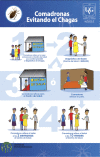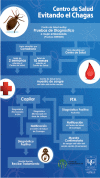Towards Chagas disease elimination: Neonatal screening for congenital transmission in rural communities
- PMID: 28892479
- PMCID: PMC5634652
- DOI: 10.1371/journal.pntd.0005783
Towards Chagas disease elimination: Neonatal screening for congenital transmission in rural communities
Abstract
Chagas disease is a neglected tropical disease that continues to affect populations living in extreme poverty in Latin America. After successful vector control programs, congenital transmission remains as a challenge to disease elimination. We used the PRECEDE-PROCEED planning model to develop strategies for neonatal screening of congenital Chagas disease in rural communities of Guatemala. These communities have persistent high triatomine infestations and low access to healthcare. We used mixed methods with multiple stakeholders to identify and address maternal-infant health behaviors through semi-structured interviews, participatory group meetings, archival reviews and a cross-sectional survey in high risk communities. From December 2015 to April 2016, we jointly developed a strategy to illustratively advertise newborn screening at the Health Center. The strategy included socioculturally appropriate promotional and educational material, in collaboration with midwives, nurses and nongovernmental organizations. By March 2016, eight of 228 (3.9%) pregnant women had been diagnosed with T. cruzi at the Health Center. Up to this date, no neonatal screening had been performed. By August 2016, seven of eight newborns born to Chagas seropositive women had been parasitologically screened at the Health Center, according to international standards. Thus, we implemented a successful community-based neonatal screening strategy to promote congenital Chagas disease healthcare in a rural setting. The success of the health promotion strategies developed will depend on local access to maternal-infant services, integration with detection of other congenital diseases and reliance on community participation in problem and solution definition.
Conflict of interest statement
The authors have declared that no competing interests exist.
Figures





Similar articles
-
Congenital Chagas Disease in the Ecuadorian Amazon: Maternal Screening at Delivery and Evaluation of Risk Factors Associated with Vector Exposure.Am J Trop Med Hyg. 2019 Dec;101(6):1350-1358. doi: 10.4269/ajtmh.19-0340. Am J Trop Med Hyg. 2019. PMID: 31595866 Free PMC article.
-
Cultural perception of triatomine bugs and Chagas disease in Bolivia: a cross-sectional field study.Parasit Vectors. 2019 Jun 10;12(1):291. doi: 10.1186/s13071-019-3546-0. Parasit Vectors. 2019. PMID: 31182163 Free PMC article.
-
[Screening for congenital infection by Trypanosoma cruzi in France].Bull Soc Pathol Exot. 2009 Dec;102(5):300-9. Bull Soc Pathol Exot. 2009. PMID: 20131424 Review. French.
-
[Seroprevalence and vertical transmission of Chagas disease in a cohort of Latin-american pregnant women in a tertiary hospital in Madrid].An Pediatr (Engl Ed). 2018 Mar;88(3):122-126. doi: 10.1016/j.anpedi.2017.03.003. Epub 2017 Apr 12. An Pediatr (Engl Ed). 2018. PMID: 28411096 Spanish.
-
Control and management of congenital Chagas disease in Europe and other non-endemic countries: current policies and practices.Trop Med Int Health. 2016 May;21(5):590-6. doi: 10.1111/tmi.12687. Epub 2016 Mar 17. Trop Med Int Health. 2016. PMID: 26932338 Review.
Cited by
-
Biopharmaceutical Characteristics of Nifurtimox Tablets for Age- and Body Weight-Adjusted Dosing in Patients With Chagas Disease.Clin Pharmacol Drug Dev. 2021 May;10(5):542-555. doi: 10.1002/cpdd.871. Epub 2020 Oct 8. Clin Pharmacol Drug Dev. 2021. PMID: 33029953 Free PMC article. Clinical Trial.
-
Prevention of congenital chagas disease by trypanocide treatment in women of reproductive age: A meta-analysis of observational studies.PLoS Negl Trop Dis. 2024 Sep 5;18(9):e0012407. doi: 10.1371/journal.pntd.0012407. eCollection 2024 Sep. PLoS Negl Trop Dis. 2024. PMID: 39236037 Free PMC article.
-
The Importance of Screening for Chagas Disease Against the Backdrop of Changing Epidemiology in the USA.Curr Trop Med Rep. 2022;9(4):185-193. doi: 10.1007/s40475-022-00264-7. Epub 2022 Sep 10. Curr Trop Med Rep. 2022. PMID: 36105114 Free PMC article. Review.
-
A decade of vector control activities: Progress and limitations of Chagas disease prevention in a region of Guatemala with persistent Triatoma dimidiata infestation.PLoS Negl Trop Dis. 2018 Nov 6;12(11):e0006896. doi: 10.1371/journal.pntd.0006896. eCollection 2018 Nov. PLoS Negl Trop Dis. 2018. PMID: 30399143 Free PMC article.
-
Knowledge Production on Congenital Chagas Disease across Time, Borders and Disciplines: A Comprehensive Scoping Review.Trop Med Infect Dis. 2023 Aug 22;8(9):422. doi: 10.3390/tropicalmed8090422. Trop Med Infect Dis. 2023. PMID: 37755884 Free PMC article.
References
-
- Hashimoto K, Alvarez H, Nakagawa J, Juarez J, Monroy C, Cordón-Rosales C, Gil E. Vector control intervention towards interruption of transmission of Chagas disease by Rhodnius prolixus, main vector in Guatemala. Mem. Inst. Oswaldo Cruz 2012; 107: 877–887. - PubMed
-
- Ministerio de Salud de la Nación. Enfermedades infecciosas Chagas, atención del paciente con enfermedad de Chagas. Minist. Salud Argentina 2010; 7: 1–35.Available from: http://www.msal.gob.ar/images/stories/epidemiologia/pdf/guia-medica-equi...
-
- Rendell VR, Gilman RH, Galdos-Cardenas G, Valencia E, Verastegui M, Sanchez L, et al. Trypanosoma cruzi-infected pregnant women without vector exposure have higher parasitemia levels: implications for congenital transmission risk. PLoS One 2015; 10: p. e0119527 doi: 10.1371/journal.pone.0119527 - DOI - PMC - PubMed
-
- Brutus L, Castillo H, Bernal C, Salas NA, Schneider D, Santalla JA, et al. Short report: Detectable Trypanosoma cruzi parasitemia during pregnancy and delivery as a risk factor for congenital chagas disease. Am. J. Trop. Med. Hyg. 2010; 83: 1044–1047. doi: 10.4269/ajtmh.2010.10-0326 - DOI - PMC - PubMed
MeSH terms
Grants and funding
LinkOut - more resources
Full Text Sources
Other Literature Sources
Medical
Miscellaneous

